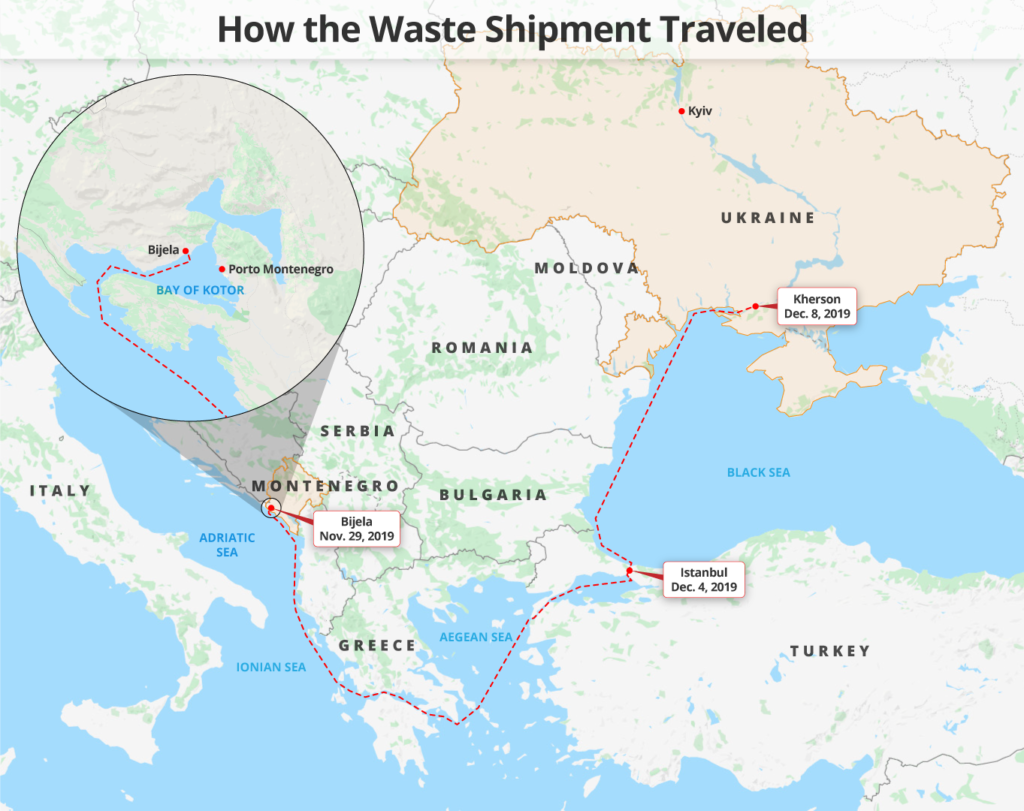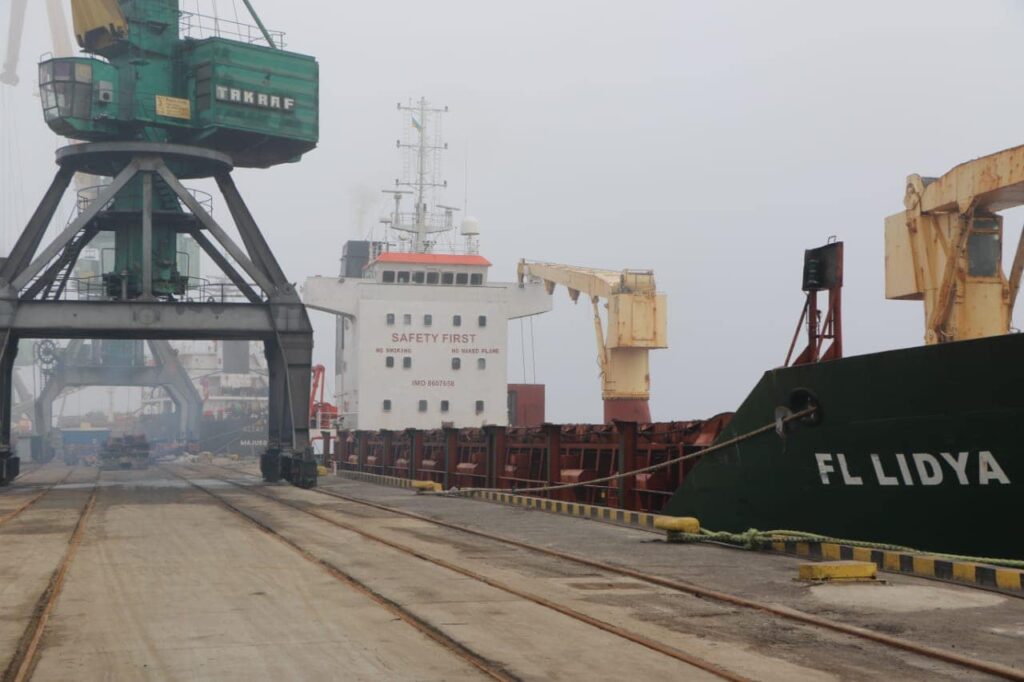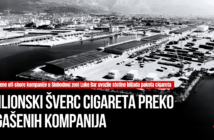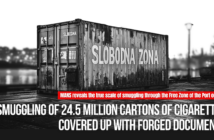Authors Lazar Grdinić (MANS) Vlad Lavrov (OCCRP) Jared Ferrie (OCCRP)
Nearly 4,000 tons of grit waste originating from Montenegro have been in the Ukrainian port of Kherson for more than a year, after the local police opened an investigation into how the French company Valgo shipped that hazardous waste from Bijela at the end of 2019. “Valgo” is engaged in the project of soil remediation of the former Shipyard Bijela, financed from the World Bank loan.
At the end of November 2019, a ship “FL Lidya” sailed from Bijela to Ukraine, carrying grit waste in the amount of almost 4,000 tons, for which “Valgo” had previously obtained a permit from the Agency for Nature and Environment Protection of Montenegro to export the so-called “non-hazardous contaminated grit waste”.
Taking over of grit waste from Montenegro was done by the local company “Firma Arka”, with which “Valgo” concluded a special contract, and which is now under investigation by the Ukrainian police due to suspicion that it submitted falsified documents in the process of obtaining permits and thus violated environmental safety procedures in Ukraine.
Namely, the results of a Ukrainian laboratory showed that the grit waste from Montenegro, seized in the port of Kherson, was extremely poisonous, as well as that it had a “pronounced mutagenic and carcinogenic effect”.
The data obtained by the MANS Investigative Centre show that in the process of obtaining an export permit from the Agency for Nature and Environment Protection of Montenegro, the company “Valgo” submitted the findings of the Center for Ecotoxicological Research (CETI) for inspection, which states that the grit waste actually originates from the “Porto Montenegro” complex in Tivat, as well as that it is a non-hazardous type of waste, which is different in its characteristics from the hazardous grit from Bijela.
The document of the Ukrainian laboratory, obtained by MANS in cooperation with colleagues from OCCRP, was forwarded to CETI with a request to interpret the difference between Montenegrin and Ukrainian findings, as well as to provide an explanation on how it is possible that the grit waste was declared non-hazardous in Montenegro, and hazardous in Ukraine.
– “What leads us to the conclusion that these are completely different samples is the result of the content of total petroleum hydrocarbons (TPH). Namely, as it is known, there was no such high TPH content found in any analysed samples of grit waste sampled by CETI at the Bijela and Porto Montenegro sites. Namely, TPH content in grit waste did not exceed 0.5%, although based on the determined TPH content, a large part of waste grit from Shipyard Bijela (sampled in 2015) and waste grit from Porto Montenegro (sampled in 2009) was characterized as hazardous waste. The high content of TPH (over 1%) was found in soil samples from the Bijela site in the period 2015-2016”, Danijela Šuković, Director of the Sector for Laboratory Diagnostic and Radiation Protection at CETI, stated.
CETI also notes that the representatives of the French company personally sampled the analysed grit and stated that it originated from the “Porto Montenegro” site, while they cannot claim that it was done according to a proper procedure.
The company “Adriatic Marinas”, which manages the luxury complex in Tivat, states that the grit waste was taken from their location on the basis of a separate agreement between the companies “Adriatic Marinas” and “Valgo Montenegro”, a subsidiary of the company “Valgo” in Montenegro.
The grit waste was transferred from Tivat to Bijela in the spring of 2019.
– “The material was temporarily stored there on a completely separate and covered plot until it was transported by the company “Valgo” by sea, together with other waste from the Shipyard Bijela, to its final destination, i.e. licensed landfill, the company “Adriatic Marinas” stated.
On the other hand, despite several inquiries from the Investigative Centre of the NGO MANS and the Organized Crime and Corruption Reporting Project (OCCRP), “Valgo” company did not provide answers on how hazardous waste from Montenegro got to Ukraine.
The Environmental Protection Agency, which issued a permit for the export of grit waste that turned out to be hazardous, told MANS that they knew about the investigation in Ukraine, and that they had respected the international documents that regulate this area.
– “The contract between “Valgo Montenegro” and “VK Firma Arka” is an integral part of the note on the export of non-hazardous waste in accordance with the Basel Convention on the Control of Transboundary Movements of Hazardous Wastes and their Disposal submitted by “Valgo Montenegro”. In accordance with the said legislation, the Agency forwarded the note to the competent authority of Ukraine.”
According to the Ministry of Ecology, Spatial Planning and Urbanism (former Ministry of Sustainable Development and Tourism – MSDT), they are familiar with the current investigation in Ukraine, and they have communication with the Ukrainian Ministry of Energy and Environmental Protection.
– “Due to inability of permanent disposal of this waste in Montenegro, exporting started, so it is quite clear that the return of waste to Montenegro is not the most favourable solution, noting that even after the possible return of waste, the exporter from Montenegro has an obligation to find another destination. Montenegro will use all legal mechanisms to bear the burden of the costs of eventual return to the exporter from Montenegro.”
Until then, the grit waste for which remains unclear whether it originated exclusively from Tivat or was mixed with grit from Bijela and thus exported, remains “trapped” in the Ukrainian port, while Montenegro is facing a major international environmental scandal.
Permit issued by the Environmental Protection Agency to company Valgo
CETI findings on the basis of which Valgo got a permit
Findings of the Ukrainian laboratory (original)
Findings of the Ukrainian laboratory (translation)
Report of the Ukrainian laboratory
REHABILITATION PROJECT FOR SHIPYARD BIJELA
French company “Valgo” was hired at an international tender by the Agency for Nature and Environment Protection of Montenegro to rehabilitate and clean the area of the former Shipyard Bijela from highly hazardous grit, contaminated soil and oil, which is why the location in Bijela was marked as ecological “black spot”. Montenegro has taken a loan from the World Bank of about 50 million euros to solve this and three other similar issues on its territory.
Valgo previously exported grit waste to Spain, to the province of Huelva, until September 2019, when Spanish regional authorities refused to issue additional permits for the import of grit waste, all due to the alleged “lack of capacity” of the landfill where the grit waste from Bijela was treated.
The deadline for the completion of the soil remediation project of the former Bijela Shipyard was June 2020, but it was extended until June 2021.
In November 2018, the Government of Montenegro gave the area of the shipyard port in Bijela for concession to a consortium consisting of the companies “Adriatic Marinas”, the owner of the complex “Porto Montenegro” and “B.V. Holding Maatschappij Damen” from the Netherlands.
However, the Dutch company “Damen” left this job last fall, while in the previous term, headed by the Prime Minister Duško Marković, the Government of Montenegro approved that the share of the Dutch company in the concession arrangement be taken over by “Dry Docks World – Dubai LLC” (DDW), which resulted in the signing of an annex to the contract in November 2020. The concession was granted for a period of 30 years, and the concessionaires will not take over the area until it is completely cleared of grit and other substances, which is the obligation of the Montenegrin authorities, on which most of the World Bank loan is spent.
According to the Agency for Nature and Environment Protection, headed by Nikola Medenica (Social Democrats of Montenegro), they do not believe that the problem in Ukraine caused the delay of the project in Bijela.
“However, if responsibility of the company “Valgo SA” is determined in this dispute, it may not only carry a certain reputational risk for this company, but it may also have a negative impact on the implementation of the Industrial Waste Management and Clean-up Project (IWMCP) in Montenegro.”
GRIT WASTE FROM PORTO MONTENEGRO
Grit in the “Porto Montenegro” complex was created during the former Naval Technical Repair Institute “Sava Kovačević”, also known as “Arsenal Tivat”, while the company “Adriatic Marinas” – which manages the luxury complex, has repeatedly broke the deadline for the removal of grit since 2010, for which they were punished by the environmental inspection.
According to the environmental impact assessment study prepared for the needs of the premises of the “Porto Montenegro” complex from 2010, “Adriatic Marinas” was supposed to remove all temporarily stored quantities of grit waste and contaminated land by the end of 2011. Nevertheless, the Department for Environmental Inspection of the Administration for Inspection Affairs submitted requests for initiating misdemeanour proceedings against the company twice, precisely due to breaking these deadlines, in March 2013 and May 2015.
In first case, “Adriatic Marinas” was fined 1,000 euros, while the second misdemeanour procedure was suspended because the deadline for removing the grit was then extended until the end of 2017, and then until the end of 2018, for the grit waste from Tivat to be finally transferred to Bijela in March 2019.





